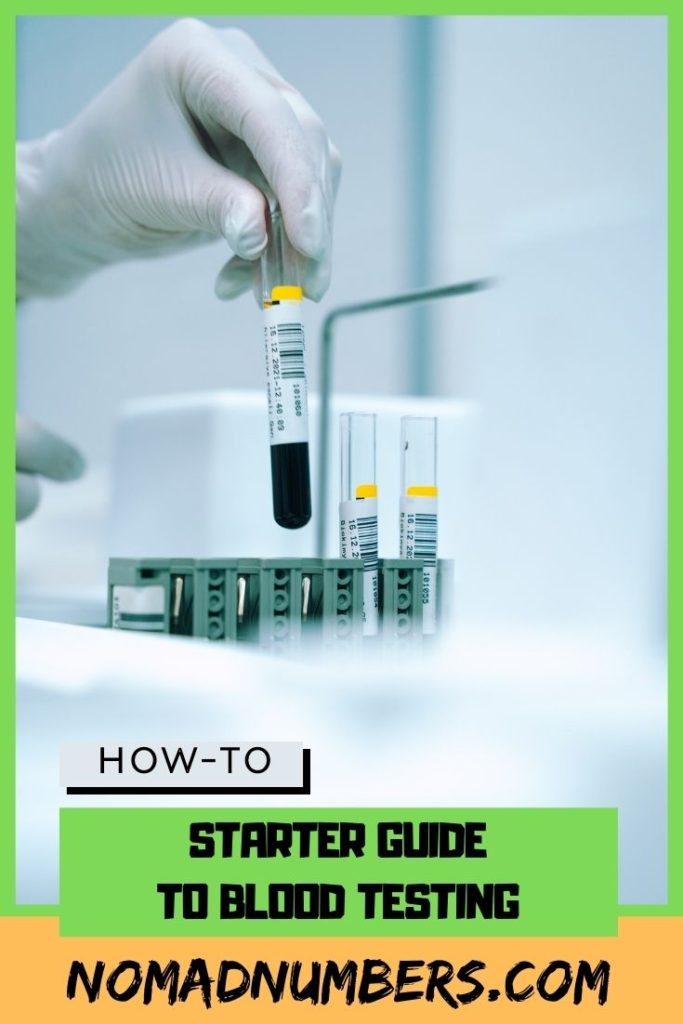This post is part of a series of how-to articles where we share our experience on how we get important stuff done in the country we visit by navigating the local rules, processes, and cultural differences. For other related posts of that series, go here.
In this guide, you will find everything you need to know about blood work. What are they? Why are they important to monitor your health, what type of test are available, which ones you want to order, where to get such tests done and how much it costs.
Are you ready to learn more about blood tests?
This page may contain affiliate links. Please read our disclaimer page for more info.
Disclaimer: This blog is for general informational purposes only and does not constitute the practice of medicine, nursing or other professional health care services, including the giving of medical advice. The use of information on this blog or materials linked from this blog is at the user’s own risk. The content of this blog is not intended to be a substitute for professional medical advice, diagnosis, or treatment.
What is a blood test?
A blood test is a laboratory analysis performed on a blood sample that is usually extracted from a vein in the arm using a hypodermic needle, or via finger prick. (source: Wikipedia)
Why do blood tests?
Getting tested at routine intervals can allow you to see the way your body changes over time and empower you to make informed decisions about your health. Some people would argue that regular blood testing is one of the most important ways to keep track of your overall physical well-being and as someone that loves to measure things before improving them, I definitely agree!
Compared to anatomy checks (breathing, heart rate, blood pressure, eyes, ears…) blood tests provide the following advantages:
- Precision: blood tests provide a precise measurement of your body’s health that can be repeated over time and will retain the same level of accuracy
- Organ health: blood tests let you assess how key organs operate in your body
- Infections: blood borne infections (meningitis – inflammation of the brain and spine lining, osteomyelitis – bone infection, sepsit – body extreme response to an infection, parasitic diseases – ) can be confirmed with a blood test.
- Chronic illness: diabetes, kidney failure, coronary artery diseases can be assessed with a blood test.
Blood tests are often interpreted by your physician (because they can be quite intimidating and also hard to decipher) and they are usually ordered once you are sick to help diagnose the issue. Instead I prefer to understand them and order them proactively (usually twice a year). Since we are nomadic and our environment changes often (diet, air / water quality, climate…), it is even more important to check on our health in my humble opinion.
It turns out that getting a basic education about blood tests isn’t that hard. There are wonderful resources online that you can use for free to input your own blood test results, track your results over time and get pretty good insights into what each number means. Plus if you get to understand your blood test results, then you don’t even need to see a doctor and you can just order the test at a lab!
What type of blood tests to order?
Did you know that there are hundreds of types of blood tests available to order? The difficulty usually is understanding what they are about and which one to order.
This can be quite overwhelming at first and I spent many hours trying to learn about blood. While this is far from being exhaustive, here are a few types of tests you can order and information to help you understand how to read the results.
To make it easier I’ve grouped the most common tests based on what information you might want to know about your health.
Note: (↑) means high, (↓) means low. When these are used in the tables below, they indicate the ideal value.
| I want to know more about the health of… | Order the following tests… | As they can help you understand… |
| My heart | Triglycérides (↓)Total Cholesterol (↓) (HDL+VLDL+LDL) VLDL Cholesterol (↓)HDL Cholesterol (↑)LDL Cholesterol (↓)Apo-B (↓)Apo-A1 (↑) | Risk of atherosclerosis (stroke or heart attack) which are associated with high-cholesterol and high levels of Apolipoprotein-B (even though the LDL-Cholesterol might be high). For more, watch this video. |
| Overall cell health | Iron (↓)Ferritin (↓) Folic AcidB12RBC Magnésium | mitochondria, DNA and cell damage as well as your ability to generate energy for your cells (ATP) For more check this video. |
| Diabetes | InsulinFasting glucoseHemoglobin A1CIGF-1Cortisol | Your risk of becoming insulin resistant and develop lifelong diabetes For more check this video. |
| My thyroid | Thyroid Stimulating Hormone (TSH)T4T3Free-T4Free-T3Reverse-T3 | Check this video |
| My blood | Red blood cellsPlatelets Vitamin D Vitamin C Iron Magnésium Calcium | |
| My liver | Albumin ↑AST ↓ ALT ↓BUN ↑ | |
| My kidney | Calcium | |
| My blood | Red blood cellsPlatelets Vitamin D Vitamin C Iron Magnésium Calcium | |
| My immune system | White blood cells | |
| Transporting and utilizing oxygen | Vitamin 12 (↑) Feratin (↑) Folate (↑) | |
| Managing inflammation | hs-CRP (↓)Cortisol level (↓) |
Where to get your blood test?
Assuming you know what you want to get tested, the next step would be to order your tests.
I like to go to a lab and order my tests “a la carte”. This is usually more extensive than the basic blood test that your physician will usually order for you as part of an annual checkup. This can also be more expensive. That being said, in Asia where we’ve spent the past 2+ years, access to such tests is a fraction of the cost of what you could get in the US.
If you are in the US, a great company to get such tests is https://www.wellnessfx.com/. It isn’t cheap (for an extensive set of tests) but it is quite simple. They also offer a free tool to let you track your result which we’ve been using.
From a cost stand point, it will cost you between $300 – $2,000 for a pretty extensive and comprehensive blood test pannel. It costed me ~350 USD to get a blood test + some metal toxicity test in Taipei.
Don’t take each result without context – the false positives!
Be careful about laboratory reference range
Labs are usually laboratory reference ranges, which usually come from people that get their blood drawn after going to the doctor, which are usually sick people. Instead of such laboratory reference ranges, you might want to instead use optimum references range. An optimum reference range would be better to help detect an issue before it is manifested in the body.
Be aware of what can affect test results!
Test results can be affected by a various things like:
- Fasting would affect glucose and triglyceride levels
- Dehydration would affect a number of markers as abnormal or actually hide something that is abnormal
- Diurnal rhythm would return different value in the morning vs at night for a given market (might be high in the morning and low at night or vice versa)
- How the blood is drawn based on how tight the tourniquet is.
What is the best time to get your blood drawn? Ideally the first thing in the morning after your fasting.
One test doesn’t give the full picture
We can’t just look at one marker outside of an overall picture to make a specific diagnosis. Things are more complex than that. Let’s take blood composition as one example. Your blood is made of formed elements (45%) and plasma (55%).
- Formed elements are red cells, white blood cells and platelets
- Plasma is made of 92% water, 7% proteins (60% albumin, 35% globulin) and 1% for representing everything else (this includes minerals, sugars, fats, hormones and vitamins, electrolytes, CO2…)
When you want to assess whether or not you have anemia (which is the inability for the body to deliver oxygen to your cell), you can look at the trio RBC (Red Blood Count), Hemoglobin + Hematocrit. If they are below the normal range you are at risk of having anemia. But because of the way a blood sample are normalized and the fact that plasma is usually 92% water, if the person is dehydrated, their amount of RBC, Hemoglobin + Hematocrit found in the blood cell material would be slightly higher than the normal range and that person can still have anemia. So in that case you want to check other markers to validate if that person was dehydrated or not. Such markers would be for instance Albumin (if >5 g/dL) or Blood Urea Nitrogen (if >25 mg/dL).
If you want to know more about this specific example, please watch the very educational Red Blood Cell Indices Part 1 and Red Blood Cell Indices Part 2 videos by Bryan Walsh.
What about after getting your results?
Now that you’ve received your results and can identify some anomalies, what should you do next?
Well, you could either talk to a physical to provide recommendations or do your own research like I did for this article. There is a lot of information online but again, talking to a physician is probably the best way to make sure you can understand your results and take the appropriate action without negatively affecting your health!
Beyond blood tests?
While blood tests can tell you a lot about your health, there are other tests you can get to get additional insights. Here are a few of them:
- You can test for metal toxicity, by analyzing your hair
- You can check for the health of your gut microbiome at home thank to kits like the Viome at-Home Gut Microbiome Test
- You can use a device to measure the quality of your sleep, like the Oura ring we love using.
Our bottom line
Alright, so this was a pretty dense article about blood tests and thanks for reading it this far. Our takeaway is that blood tests can tell you a lot about your health and can potentially save your life if you keep a pulse on your results on a regular basis. Of course, there is a learning curve if you want to understand them and hopefully you can start learning through this article. Ultimately if this is too intimidating, overwhelming or not of interest for you, you can always rely on a physician to help you decipher the data.
What about you? Do you understand your blood tests? Do you order them yourself or wait to be sick to have your physician ordering them for you? Let us know in the comments below!

——-
Additional content for those that want to dig more into blood markers
The following content is pretty detailed so rather than including it into the post, we put it on the side as not everyone might want that level of information.
Disclaimer reminder: This blog is for general informational purposes only and does not constitute the practice of medicine, nursing or other professional health care services, including the giving of medical advice. The use of information on this blog or materials linked from this blog is at the user’s own risk. The content of this blog is not intended to be a substitute for professional medical advice, diagnosis, or treatment.
Triglycerides
- If Triglycerides are high, this might be related to non fasting before the blood draw (check for glucose ↑) or due to blood sugar regulation (check for Hemoglobin H1c ↑).
- If Triglycerides are low, it could be from poor digestion and absorption, low fat diet and individuals with dysregulated immune system (like individuals with an auto-immune condition)
Total Cholesterol (TC)
- If Total Cholesterol is high this can be due to hypothyroidism (check for TSH ↑), poor liver metabolism or clearance, elevated level of insulin or blood sugar dysregulation (check for hemoglobin A1C ↑)
- If Total Cholesterol is low, (which isn’t as common as high TC), this might be related to cancer, depression, and anxiety and can be related to liver dysfunction or Excess oxidative stress, or inflammation (check Hs-CRP ↑)
- Note that high levels of TC is not the best marker for risk of cardiovascular diseases.
Other Cholesterol (HDL, VLDL, LDL)
- VLDL Cholesterol + HDL Cholesterol are high, this is related to the same reason why TC is high.
If HDL is elevated, there is an inflammatory process (check for hs-CRP ↑) in the body. - If HDL is low (with low VLDL, TC, LDL) is related to insulin resistance, blood dysregulation and metabolic syndrome tendencies.
Apolipoprotein B (Apo-B) is a surrogate marker for the number of LDL proteins in your body. The higher Apo-B the greater risk of cardiovascular diseases. Apolipoprotein A (Apo-A1) is not a 1:1 relationship with the number of HDL particles but it is a good association and the ratio Apo-B/Apo-A1 in particular is a very good indicator of cardiovascular risk.
Insulin is a hormone produced by the liver that will ask the cell to store glucose.
- If Insulin is ↑ and fasting glucose is normal/↓, hemoglobin A1C is normal, you have an hyperglycemia tendency and this might be the first step into insulin resistance and diabetes down the line
- If Insulin is ↑ and Fasting glucose is normal but hemoglobin A1C is normal (5.7-5.8) – Glucose dysregulation. The pancreas is producing more insulin because the glucose is not getting store in the cell because insulin receptors on the cells are not working properly
- If Insulin is ↑ and fasting glucose is ↑ the cell are not storing glucose because of insulin resistance
- If Insulin is normal and fasting glucose is ↑ that indicates the pancreas can’t produce enough insulin.
- If Insulin is ↓ and fasting glucose is ↑ is an indication that insulin can’t be produced anymore.
IGF-1 is a hormone produced by the liver. It increases cell proliferation and growth and decreases the ability for a cell to die. IGF-1 can be reduced due to poor sleep, excess body fat, lack of strength exercise, hyperglycemic tendency or excess insulin.
Cortisol is the body’s main stress hormone. It helps maintain stable levels of glucose in the body. It is usually high in the morning and low at night.
- People with high levels of cortisol usually have high fasting glucose and insulin levels which can lead to insulin resistance. High levels of Cortisol are also associated with poor cell repairs (you can feel sore after many days post exercise if you have chornolic high level of cortisol).
- People with low levels of cortisol usually have a higher sensation of pain in the body. Muscle weakness and overall fatigue. It is also related to poor sleep. People will have low blood pressure and trigger dehydration.
Iron
- Iron is highly toxic and will lead to excessive oxidative stress that will damage your cells.
- Why Iron can be high?
- Excess consumption – pipes in your house made of iron, cast iron skillet
- Since Iron isn’t a stable marker (it can fluctuate during the day), check Ferritin (Ferritin is a storage form of iron) for a stable marker. High levels of Ferritin would confirm iron overload. High level of Iron with low level of Ferritin however may be symptoms of acute inflammation (check hs-CRP ↑), low level of Vitamin C as well as hypothyroidism (check for TSH ↑).
- Why Iron can be low?
- Intake – Low protein intake and getting Iron through vegetables that are not a good source of Iron.
- Absorption – High level of green tea can impact absorption of metals like Iron
- Loss – due to menstrual cycle for women or some form of gastrointestinal tract inflammation/bleeding
Fold Acid + B12 are related to DNA repair. Folic acid can be increased by intake of green leafy vegetables and B12 by intake of meat.
Magnesium helps the body turn ADP into ATP (which is the energy that all your cells need to function properly).
Thyroid
- Thyroid Stimulating Hormone (TSH) – It will make T3 (7%) and T4 (93%) in the thyroid gland. 99% of T3 and T4 produce are bound to TBG (thyroxine binding globulin) for transportation purposes.
- Free T3 and Free T4 – these are unbounded versions of T3 and T4 that can be used by the body.
- T4 in the liver can be converted into T3 (active) and Reverse T3 (metabolic inactive).
- To convert T4 to T3 you need Selenium. If Free T3 is low you can’t stimulate the cell of the body to do what the cell should do.
White Blood Cell Count (WBC) – If it’s elevated it shows an acute infectious or inflammatory process. If it is low it indicates a chronic infectious or inflammatory process.
Neutrophil – They are the most abundant kind of WBC and indicate bacteria information. High level coupled with high WBC means acute infection. High level coupled with low WBC means chronic infection.
Lymphocyte – High level can indicate either a viral infection or an autoimmune condition. High level coupled with high WBC means acute infection. High level coupled with low WBC means chronic infection.
Monocyte – leave the blood to become macrophage and clean up the cellular debris. High level says that there is some kind of inflammatory response occurring in the body.
Eosinophil – High level indicates someone with a seasonal allergy history or with sone parasitic infection
Basophil – High level indicates some pretty severe allergy of asthma.
Note: if you have ↓ RBC, ↓ Hemoglobin, ↓ Hematocrit, ↑ MCV, ↑ MCH, ↑ MCHC, RW ↑ homocysteine, ↓ serum B12, ↓ serum folic acid you might have a deficiency in B12 / folic acid deficiency leading to less production of Neutrophil which would artificially increase the relative value of Lymphocyte.
For more watch this video.
Fibrinogen is an inactive plasma protein made in the liver that is used anytime there is vascular layer damage. It is activated when the body needs to repair itself. High levels of Fibrinogen increase risk of cardiovascular diseases as there are extensive repairs being done that can lead to blood clot. Low level might be a sign of inflammation (if all the fibrinogen has been used for repair for instance).
Calcium and Vitamin D (for more check this video)
Calcium in blood chemistry does not reflect calcium intake because the body can regulate how much Calcium it needs and get rid of any excess.
- Because a serum calcium is calcium bound to albumin, if serum calcium level is low and your albumin level is low, you need to use a calcium correction formula to estimate your real calcium. Formula is [0.8x (4.0+albumin_value)) + serum_calcium_value] there is a calcium correction score formula that can be used to define the adjusted calcium value.
- Calcium regulation:
- If calcium is low, your body can break bones to extract calcium. This is done via release of ParaTHyroid hormone (PTH) hormone.
- PTH hormone can also let the kidney to filter from the blood in the kidney that can be then re-absorbed (instead of being excreted by urine)
- PTH hormon can also increase an enzyme that transforme inactive Vitamin D into active Vitamin D
Vitamin D has been associated with increased risk of cancer, diabetes and other diseases so it is important to monitor. Vitamin D is produced as follows: the skin produces a compound that is converted by the liver using a specific enzyme (this produces the inactive form of vitamin D called 25 hydroxy form). It is then converted into the active form of Vitamin D (called 1,25 dihydroxy form)
- ↑ calcium is due to either ↑ Vitamin D or ↑ level of PTH
- ↓ calcium is due to ↓ Vitamin D level or ↓ PTH hormone
- ↑ Vitamin D is due to overconsumption of supplemental Vitamin D
- ↓ Vitamin D is due to lack of consumption, sunlight exposure, liver dysfunction or kidney dysfunction.
Note: on a blood test, what is being tested is the 25 hydroxy form of Vitamin D (aka 25[OH] D).



0 Comments